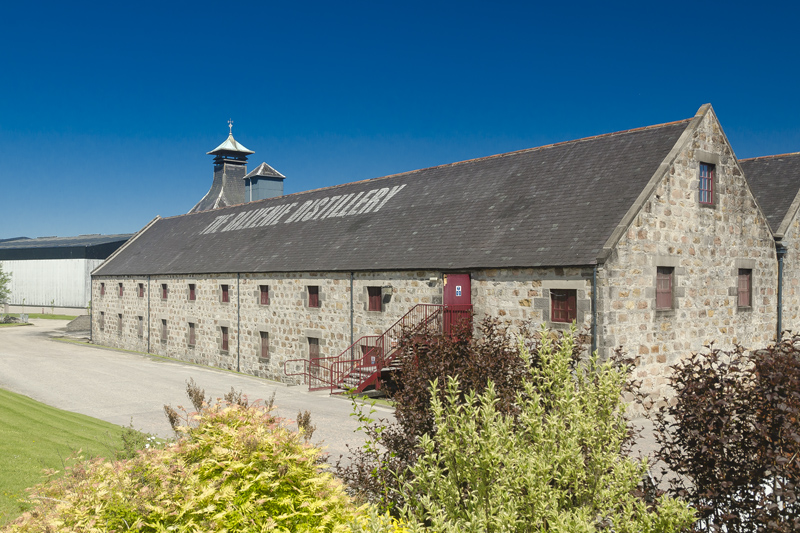Balvenie
2016-09-10
 Balvenie in a nutshell:
Balvenie in a nutshell:founded: 1892
owner: William Grant & Sons
region: Speyside
location: 57° 27’ 31” N 03° 07’ 42” W
status: active
capacity: 6,800,000 litres
washbacks: 9 Oregon pine, 5 stainless steel
stills: 11
source of water: Robbie Dubh burn
tours: yes
Balvenie
For many years, Balvenie was treated as a younger, less prominent sister of the mighty Glenfiddich, and the charm of the whisky made here was appreciated only by a bunch of connoisseurs. In the last decade that situation changed dramatically, and David Stewart’s activity has brought Balvenie to much wider public and gigantic growth in sales. It is hard to believe now that initially it was to be named Glen Gordon, although eventually it took its name from the nearby medieval castle, whose ruin, obscured by surrounding trees, overlook the Glenfiddich-Balvenie-Kininvie complex from a hill across the road.
The continuously growing popularity of Balvenie bottled as a single malt whisky has forced the Grants to build a new, totally modern Ailsa Bay distillery, whose stills were shaped to imitate those at Balvenie – so that it can take over the burden of Balvenie-profile whisky for blending purposes and so that the Balvenie spirit can be bottled as single malt in larger quantities.
When William Grant made a decision to build a new distillery in 1892, he brought some of the equipment from Lagavulin and Glen Albyn distilleries. It was the whisky boom period that brought a few dozen new distilleries, of which just over a dozen have survived and are still active today, including Glenrothes, Aberfeldy, Craigellachie, Longmorn, Dalwhinnie and Benriach. The first spirit flowed from the Balvenie stills the next year, in 1893. What followed in the history of Balvenie is... pure boredom – it has been in the founders’ hands ever since, there have been no sudden downturns or twists, natural disasters, bankruptcies or takeovers. Production still takes place in the same place, the same – more or less – buildings. The number of stills has been steadily growing – the original two, installed there in 1892, turned into four in 1957, six in 1965 and eight in 1971. In 2008 the number of stills grew to eleven, operating in two still houses.
Balvenie is one of the few Scotch whisky distilleries that have preserved original malting floors. These days it caters for only 15% of the demand for malted barley, with the rest, just like the malt for Glenfiddich and Kininvie, is brought from specialist maltings. Each year, a small fraction of the production uses highly peated malt (45-50 ppm). Single malt whisky from Balvenie debuted relatively early in the history of Scotch whisky, that is in 1973, and the Founder’s Reserve, the core expression, was launched in 1982, but the widespread popularity was gained only thanks to expressions released at the end of the last millennium and in the early noughties. One of the most notable among them was the 12 year old DoubleWood, one of the first widely promoted single malt whiskies that had undergone the process of wood finishing, that is additional maturation in a specific type of cask, ex-sherry in this case. The 15yo Single Barrel, released in small batches and the 21yo PortWood deserve a mention, too.
Balvenie was actually one of the pioneers of the now ubiquitous trend to mature whiskies additionally, for a relatively short period in casks that previously held other tipples, notably sherry and port, but also rum, madeira or even another type of Scotch whisky, e.g. some peated Islay malt. 2013 saw the launch of the Triple Cask, composed of whiskies matured partly in first fill ex-bourbon casks, partly in refill ex-bourbon casks and first fill sherry.
Whisky distilled at Balvenie is available only as official expressions, bottled by William Grant & Sons. When casks of Balvenie – or Glenfiddich and Kininvie, for that matter – are sold outside for blending purposes, there is always a tiny amount of either of the other two malts added to the cask. It is too small to have an impact on the overall profile and flavour of the whisky, but technically it is no longer a single malt, so it cannot be bottled and sold as such. No wonder there are practically no independent bottlings of Balvenie, Glenfiddich or Kininvie.
Show more entries from
September 2016